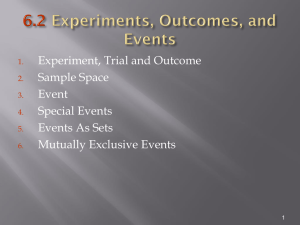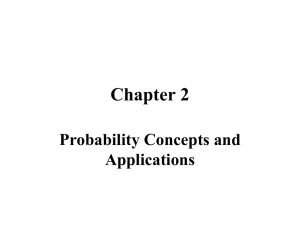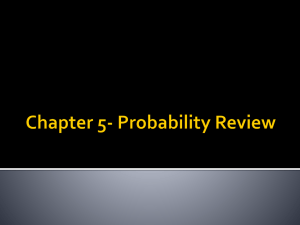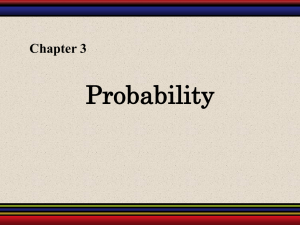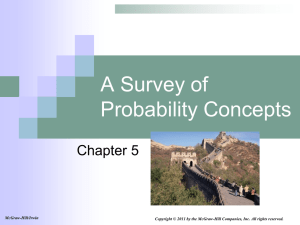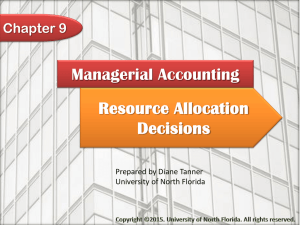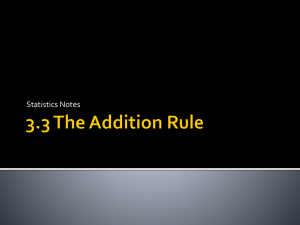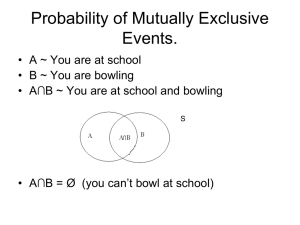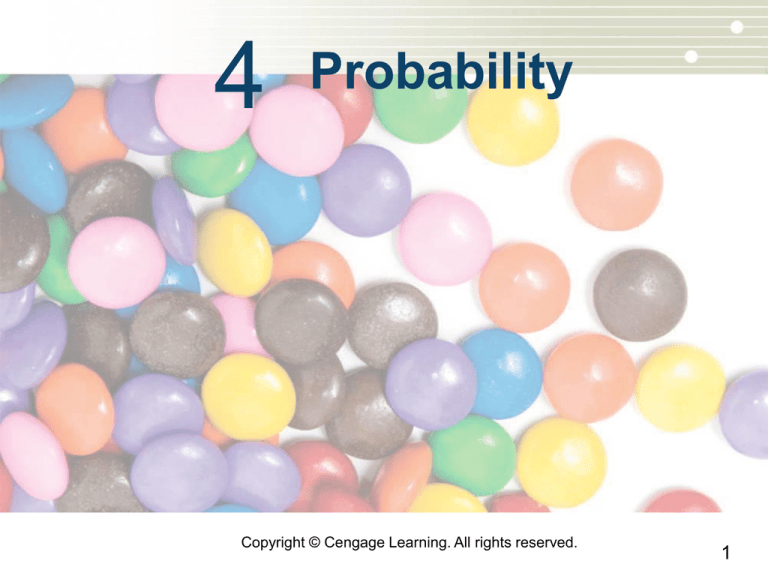
4
Probability
Copyright © Cengage Learning. All rights reserved.
1
4.4
Mutually Exclusive
Events
Copyright © Cengage Learning. All rights reserved.
Mutually Exclusive Events
Mutually exclusive events are nonempty events defined
on the same sample space with each event excluding the
occurrence of the other.
In other words, they are events that share no common
elements. In algebra: P(A and B) = 0
There are several equivalent ways to express the concept
of mutually exclusive:
1. If you know that either one of the events has occurred,
then the other event is excluded or cannot have
occurred.
3
Mutually Exclusive Events
2. If you are looking at the lists of the elements making up
each event, none of the elements listed for either event
will appear on the other event’s list; there are “no shared
elements.”
3. The equation says, “the intersection of the two events
has a probability of zero,” meaning “the intersection is an
empty set” or “there is no intersection.”
4
Mutually Exclusive Events
Note
The concept of mutually exclusive events is based on the
relationship between the sets of elements that satisfy the
events.
Mutually exclusive is not a probability concept by definition;
it just happens to be easy to express the concept using a
probability statement.
5
Understanding Mutually Exclusive
(and Not Mutually Exclusive) Events
6
Understanding Mutually Exclusive (and Not Mutually Exclusive) Events
To help understand the difference between mutually
exclusive and not mutually exclusive events, let’s look at
some examples.
7
Understanding Mutually Exclusive (and Not Mutually Exclusive) Events
Consider a poll of 1,000 voters in 25 precincts across the
country during the 2008 presidential election, which
provided the following:
8
Understanding Mutually Exclusive (and Not Mutually Exclusive) Events
Suppose one voter is selected at random from the 1,000
voters summarized in the table. Consider the two events
“The voter selected voted for McCain” and “The voter
selected voted for Obama.”
In order for the event “the selected voter voted for McCain”
to occur, the selected voter must be 1 of the 510 voters
listed in the “Number for McCain” column.
In order for the event “the selected voter voted for Obama”
to occur, the voter selected must be 1 of the 477 voters
listed in the “Number for Obama” column.
9
Understanding Mutually Exclusive (and Not Mutually Exclusive) Events
Because no voter listed in the McCain column is also listed
in the Obama column and because no voter listed in the
Obama column is also listed in the McCain column, these
two events are mutually exclusive.
In equation form:
P(voted for McCain and voted for Obama) = 0.
Now, let’s look at the same situation but from a different
angle to understand not mutually exclusive events.
10
Understanding Mutually Exclusive (and Not Mutually Exclusive) Events
Consider the same poll of 1,000 voters in 25 precincts
across the country during the 2008 presidential election,
which provided the following:
11
Understanding Mutually Exclusive (and Not Mutually Exclusive) Events
Suppose one voter is selected at random from the 1,000
voters summarized in the table.
Consider the two events “The voter selected voted for
McCain” and “The voter selected had some college
education.”
In order for the event “the selected voter voted for McCain”
to occur, the voter selected must be 1 of the 510 voters
listed in the “Number for McCain” column.
12
Understanding Mutually Exclusive (and Not Mutually Exclusive) Events
In order for the event “the selected voter had some college
education” to occur, the selected voter must be 1 of the 320
voters listed in the “Some college” row.
Because the 172 voters shown in the intersection of the
“Number for McCain” column and the “Some college” row
belong to both of the events (“the selected voter voted for
McCain” and “the selected voter had some college
education”), these two events are NOT mutually exclusive.
13
Understanding Mutually Exclusive (and Not Mutually Exclusive) Events
In equation form:
P(voted for McCain and some college education)
= 172/1000
= 0.172, which is not equal to zero.
If you’re having trouble visualizing these concepts in terms
of politics, consider drawing one card from a regular deck
of playing cards and the two events “card drawn is a
queen” and “card drawn is an ace.”
14
Understanding Mutually Exclusive (and Not Mutually Exclusive) Events
The deck is to be shuffled and one card randomly drawn. In
order for the event “card drawn is a queen” to occur, the
card drawn must be one of the four queens: queen of
hearts, queen of diamonds, queen of spades, or queen of
clubs.
In order for the event “card drawn is an ace” to occur, the
card drawn must be one of the four aces: ace of hearts,
ace of diamonds, ace of spades, or ace of clubs.
Notice that there is no card that is both a queen and an
ace. Therefore, these two events, “card drawn is a queen”
and “card drawn is an ace,” are mutually exclusive events.
15
Understanding Mutually Exclusive (and Not Mutually Exclusive) Events
In equation form: P(queen and ace) = 0.
Similarly, we can demonstrate the concept of not mutually
exclusive events with the same regular deck of playing
cards and the two events “card drawn is a queen” and
“card drawn is a heart.”
The deck is to be shuffled and one card randomly drawn.
Are the events “queen” and “heart” mutually exclusive?
The event “card drawn is a queen” is made up of the four
queens: queen of hearts, queen of diamonds, queen of
spades, and queen of clubs.
16
Understanding Mutually Exclusive (and Not Mutually Exclusive) Events
The event “card drawn is a heart” is made up of the 13
hearts: ace of hearts, king of hearts, queen of hearts, jack
of hearts, and the other nine hearts.
Notice that the “queen of hearts” is on both lists, thereby
making it possible for both events “card drawn is a queen”
and “card drawn is a heart” to occur simultaneously.
This means that when one of these two events occurs, it
does not exclude the possibility of the other’s occurrence.
17
Understanding Mutually Exclusive (and Not Mutually Exclusive) Events
These events are not mutually exclusive events.
In equation form:
P(queen and heart) = 1/52, which is not equal to zero.
18
Visual Display and Understanding
of Mutually Exclusive Events
19
Visual Display and Understanding of Mutually Exclusive Events
How can we visually depict what happens with mutually
exclusive events?
Consider an experiment in which two dice are rolled.
Three events are defined as follows:
A: The sum of the numbers on the two dice is 7.
B: The sum of the numbers on the two dice is 10.
C: Each of the two dice shows the same number.
20
Visual Display and Understanding of Mutually Exclusive Events
Let’s determine whether these three events are mutually
exclusive.
We can show that three events are mutually exclusive by
showing that each pair of events is mutually exclusive.
Are events A and B mutually exclusive?
Yes, they are, because the sum on the two dice cannot be
both 7 and 10 at the same time.
If a sum of 7 occurs, it is impossible for the sum to be 10.
21
Visual Display and Understanding of Mutually Exclusive Events
Figure 4.5 presents the sample space for this experiment.
Sample Space for the Roll of Two Dice
Figure 4.5
22
Visual Display and Understanding of Mutually Exclusive Events
This is the same sample space shown in the chart
representation, except that ordered pairs are used in place
of the pictures.
The ovals, diamonds, and rectangles show the ordered
pairs that are in events A, B, and C, respectively. We can
see that events A and B do not intersect.
Therefore, they are mutually exclusive. Point (5, 5) in
Figure 4.5 satisfies both events B and C. Therefore, B and
C are not mutually exclusive.
23
Visual Display and Understanding of Mutually Exclusive Events
Two dice can each show a 5, which satisfies C, and the
total satisfies B.
Since we found one pair of events that are not mutually
exclusive, events A, B, and C are not mutually exclusive.
24
Special Addition Rule
25
Special Addition Rule
The addition rule simplifies when the events involved are
mutually exclusive.
If we know that two events are mutually exclusive, then by
applying P(A and B) = 0 to the addition rule for
probabilities, it follows that
P(A or B) = P(A) + P(B) – P(A and B) becomes
P(A or B) = P(A) + P(B).
In other words, when A and B are two mutually exclusive
events defined in a sample space S, “the probability of
A or B = probability of A + probability of B.”
26
Special Addition Rule
This is known as the special addition rule.
In basic algebraic terms:
P(A or B) = P(A) + P(B)
(4.6)
This formula can be expanded to consider more than two
mutually exclusive events:
P(A or B or C or . . . or E) = P(A) + P(B) + P(C) + ...+ P(E)
27
Special Addition Rule
This equation is often convenient for calculating
probabilities, but it does not help us understand the
relationship between the events A and B.
It is the definition that tells us how we should think about
mutually exclusive events.
Students who understand mutual exclusiveness this way
gain insight into what mutual exclusiveness is all about.
28
Special Addition Rule
This should lead you to think more clearly about situations
dealing with mutually exclusive events, thereby making you
less likely to confuse the concept of mutually exclusive
events with independent events or to make other common
mistakes regarding the concept of mutual exclusivity.
Note
1. Define mutually exclusive events in terms of the sets of
elements satisfying the events and test for mutual
exclusiveness in that manner.
29
Special Addition Rule
2. Do not use P(A and B) = 0 as the definition of mutually
exclusive events.
It is a property that results from the definition. It can be
used as a test for mutually exclusive events; however, as
a statement, it shows no meaning or insight into the
concept of mutually exclusive events.
3. In equation form, the definition of mutually exclusive
events states:
P(A and B) = 0
(Both cannot happen at same time.)
30
Special Addition Rule
P(A | B) = 0 and P(B | A) = 0
(If one is known to have occurred, then the other has
not.)
Reconsider our mutually exclusive card event, with the two
events “card drawn is a queen” and “card drawn is an ace”
when drawing exactly one card from a deck of regular
playing cards.
The one card drawn is a queen, or the one card drawn is
an ace.
31
Special Addition Rule
That one card cannot be both a queen and an ace at the
same time, thereby making these two events mutually
exclusive. The special addition rule therefore applies to the
situation of finding P(queen or ace).
P(queen or ace) = P(queen) + P(ace)
32

